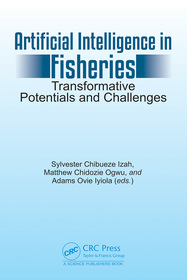
Artificial Intelligence in Fisheries
Transformative Potentials and Challenges
- Publisher's listprice GBP 130.00
-
62 107 Ft (59 150 Ft + 5% VAT)
The price is estimated because at the time of ordering we do not know what conversion rates will apply to HUF / product currency when the book arrives. In case HUF is weaker, the price increases slightly, in case HUF is stronger, the price goes lower slightly.
- Discount 10% (cc. 6 211 Ft off)
- Discounted price 55 897 Ft (53 235 Ft + 5% VAT)
Subcribe now and take benefit of a favourable price.
Subscribe
62 107 Ft

Availability
Estimated delivery time: In stock at the publisher, but not at Prospero's office. Delivery time approx. 3-5 weeks.
Not in stock at Prospero.
Why don't you give exact delivery time?
Delivery time is estimated on our previous experiences. We give estimations only, because we order from outside Hungary, and the delivery time mainly depends on how quickly the publisher supplies the book. Faster or slower deliveries both happen, but we do our best to supply as quickly as possible.
Product details:
- Edition number 1
- Publisher CRC Press
- Date of Publication 25 August 2025
- ISBN 9781032816883
- Binding Hardback
- No. of pages320 pages
- Size 234x156 mm
- Weight 750 g
- Language English
- Illustrations 14 Illustrations, black & white; 5 Illustrations, color; 5 Halftones, color; 14 Line drawings, black & white 690
Categories
Short description:
Artificial intelligence (AI) is transforming fisheries research by enhancing fish population estimates, predicting stock dynamics, and improving sustainability. AI analyzes ocean data to forecast climate patterns, supports species identification, and enforces regulations, reducing bycatch and waste.
MoreLong description:
Artificial Intelligence in Fisheries delves into the transformative role of AI in the fisheries and aquaculture. It provides a comprehensive overview of how AI applications—from fish stock assessment and environmental monitoring to sustainable aquaculture and policy development—are revolutionizing the sector. By enhancing data-driven decision-making, increasing efficiency, and addressing ecological challenges, this book serves as a practical guide for scientists, industry professionals, and policymakers.
With contributions from experts, scholars and practitioners, the book brings together theoretical foundations and real-world applications to explore AI's potential to drive sustainable practices in fisheries. Readers will gain insight into how AI can help optimize resource use, protect endangered species, and promote responsible fishing practices. It offers valuable perspectives and actionable strategies to support the future of sustainable fisheries and aquaculture.
MoreTable of Contents:
Preface. Artificial Intelligence in Fisheries: Transformative Potentials and Challenges. Data analysis and machine learning in Aquaculture: An innovative approach. Collaborate Approaches to Sustainable Fisheries with Artificial Intelligence. Fish Stock Assessment Using AI Algorithms. Sustainability Through AI in Fisheries. Artificial Intelligence for Monitoring Aquatic Pollutants: Safeguarding Ecosystem Health and Sustainable Fisheries Development. AI-Enhanced Environmental Impact Assessments in Recreational Fisheries. Artificial Intelligence Enhanced Aquaculture Practices. Computer Vision for Fish Species Identification. Deciphering Artificial Intelligence’s Impact on Fisheries Policy and Regulation for Sustainable Fisheries. Unraveling the Role of Artificial Intelligence in the Analysis of Oceanographic Data. Job Opportunities in the AI and Tech Sector. Promoting Responsible Fishing Practices with AI. AI’s Contribution to Endangered Species Conservation. Index.
More




